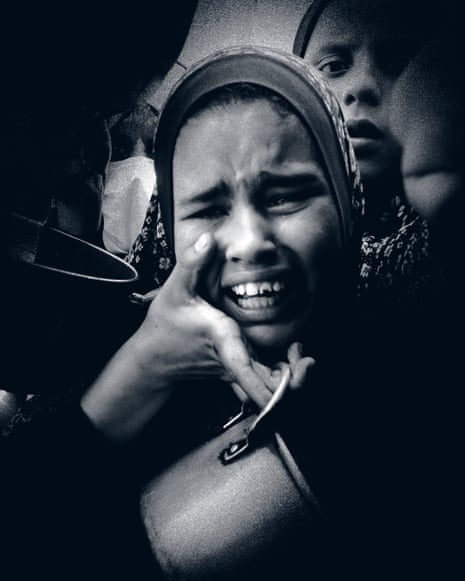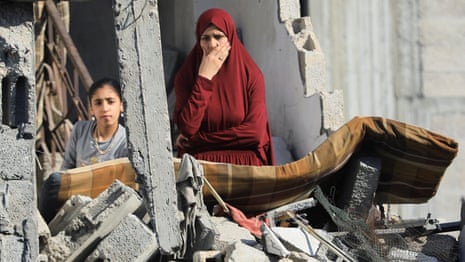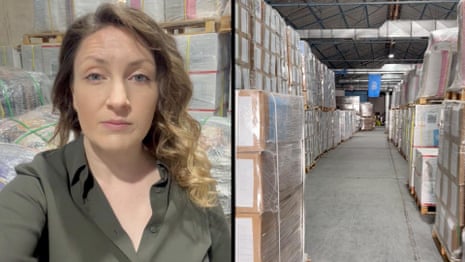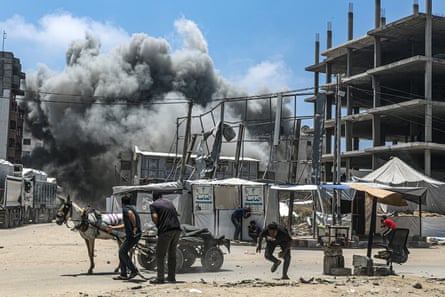
Killings in a new Israeli offensive and depleted food and medical supplies are pushing people on to the streets of the once bustling hub of GazaSun 25 May 2025 06.00 BSTShare
On the streets of Gaza City this week, there were two sounds that never ceased, day or night. In the west, the Mediterranean breakers crashed on the rubbish-strewn shoreline. In the east, the shells, missiles and rockets exploded with dull thuds and occasional ear-splitting cracks.
At least 100,000 people have come to Gaza City, once the bustling commercial and cultural hub of the Palestinian territory. All are fleeing the new offensive – dubbed Gideon’s Chariots – recently launched by Israel into the ruined towns and neighbourhoods of northern Gaza.
The blasts that the newly displaced can hear, as they crowd into makeshift shelters and hastily constructed encampments, or simply set up their tents or tarpaulins on the pock-marked pavements, sometimes come during direct clashes between Israeli troops and Hamas, though the militant Islamist organisation remains elusive, often underground.
Much more often, they are the sounds of airstrikes and artillery bombardment which have killed about 750 people and injured 2,000 more across Gaza in the last week, mostly women and children, according to medical officials there.
On Wednesday, Mohammed Abu Nadi moved his family from Jabaliya, a neighbourhood east of Gaza City that has been reduced to ruins in multiple Israeli offensives and raids.
“What happened this week was another escalation … There were relentless bombings everywhere,” the 33-year-old said. “My friend was on his way to get a vehicle to move his family to Gaza City, but when he returned, he found his home reduced to rubble. His wife and children were all killed.
“They were just young children, innocent civilians with no involvement in anything. I was shocked when it happened. I quickly carried my wife and family and left the area heading towards Gaza City.”

Abu Adam Abdul Rabbo, 55, said more than 80 members of his extended family had been killed during the 19-month conflict, which was triggered by a Hamas attack into Israel in which militants killed 1,200, mostly civilians, and abducted 251, of whom 57 remain in Gaza. The ensuing Israeli offensive has killed more than 53,000 Palestinians, also mostly civilians, and reduced much of the territory to rubble; smashing roads, health facilities, schools, religious sites, sanitation systems and much else. Israeli officials say they only attack military targets and accuse Hamas of using civilians as human shields, a charge it denies.
A week ago, Rabbo said he was woken by the sound of a huge blast that had targeted his brother’s house, killing five.
“We struggled to transfer their bodies to hospital as a quadcopter drone was firing bullets everywhere. We managed to bury them in the Jabaliya town cemetery. After that, we decided to leave, fearing for the lives of our remaining children.
“We were able to carry only a few basic items – some clothes and food. My wife was crying bitterly, asking: ‘How will we survive? What can we take with us? How long will we remain displaced?,’” Rabbo said.
This month, food security experts backed by the United Nations said the territory was at critical risk of famine, with cases of malnutrition rising rapidly.

UN warehouses in the territory are empty and most of the free bakeries that many relied on for their daily bread shut down weeks ago – though aid agencies have been able to keep some community kitchens running to produce about 300,000 meals a day. The limited food available to buy is too expensive for almost everybody, with 1kg of tomatoes or onions costing the equivalent of $13.
“Every corner of every street is crowded with people,” said Amjad Shawa, the director of the Gaza NGOs Network who is based in Gaza City. “They are living in rubbish dumps, cesspits. There are flies, mosquitoes. We have no water to deliver, no food, no tents or blankets or tarpaulins, nothing. People are very, very hungry but there is nothing to give them.”
UN officials said on Friday that their clinics and pharmacies were no longer able to offer 40% of the treatments categorised as essential by the World Health Organization. Medics interviewed last week reported seeing many abscesses and skin diseases among patients, as well as acute cases of diarrhoea and respiratory illnesses – in addition to the many injuries from airstrikes.
“We see some children with malnutrition, but everyone complains of being hungry,” said Dr Iain Lennon, a British emergency medicine consultant in Mawasi, southern Gaza. “We often see patients who are tired or dizzy because they just have not eaten enough.”
In recent days, Israel has eased the tight blockade into Gaza imposed in early March, when the first phase of a fragile ceasefire expired. On Friday, 100 trucks entered the territory, but very little aid had been distributed.
Humanitarian officials said a key problem was security. Law and order improved in the territory during the ceasefire from mid-January to March when Hamas-run police were on the streets, but it has collapsed since. Of a convoy of 20 trucks each carrying 20 tonnes of wheat flour for the World Food Programme, only three arrived at their destination on Thursday night after two broke down and 15 were hijacked by looters and driven away.
“You don’t see lines of children with rib cages and spines showing like in Africa,” said one UN official, “but there you have no roads and a population scattered over an area the size of Europe. Here, there is 130,000 tonnes of aid just the other side of the entry points into Gaza, a few kilometres away.”

Few have confidence that a US-backed Israeli scheme to bring in aid due to start next week will improve the situation. The plan involves a small number of distribution hubs in southern of Gaza being run by private contractors and protected by Israeli troops who will vet recipients. UN aid workers describe the scheme as dangerous, impractical and possibly unlawful.
Reference Link:- https://www.theguardian.com/news/ng-interactive/2025/may/25/gaza-city-israeli-offensive-despair-hunger

